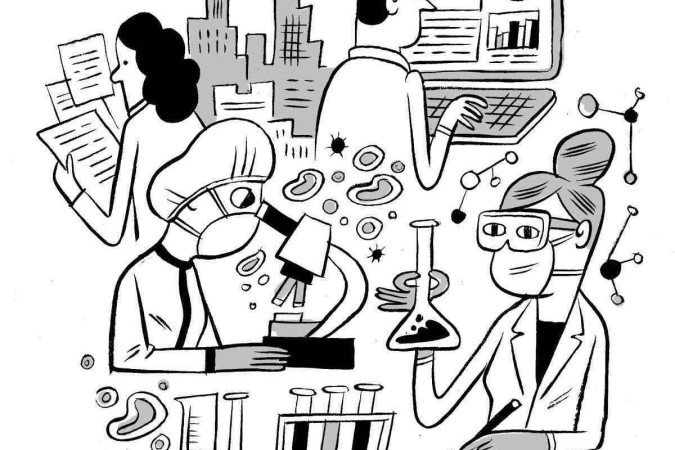Published on 01/11/2022 17:41

(credit: Cayo Gomez)
Science fairs have the ability to spark curiosity, interest, and a talent for scientific research in students. They open doors to the academic world and help students develop skills and competencies. The exhibitions will be held online and in São Paulo, Novo Hamburgo (RS), Pernambuco and Jaragua do Sul (SC). The News Agency of the National Federation of Industries has prepared a list of the most popular national fairs on Science and Culture Day, which is celebrated on the 5th of November. paying off:
Brazilian Science and Engineering Fair (February)
The Brazilian Science and Engineering Fair (Febrace) is a great opportunity to showcase your talent in STEM fields. The event takes place at the University of São Paulo (USP) and is in its 21st edition. It is intended for students and teachers in both basic and technical education throughout Brazil. Final projects are evaluated and awarded with prizes, medals and certificates, up to 4th place in each category. This event opens space for many public and private institutions to offer scholarships, internships, equipment, technical visits and credentials to participate in other national and international exhibitions. In addition, nine projects were selected to represent Brazil at the largest pre-university fair in the world: the International Science and Engineering Fair (ISEF), which was held in the United States. There is no fee to submit a project to Febrace. For finalists, a fee is charged. Information and values for this edition will be published in January on the website of stent.
Brazilian Exhibition of Young Scientists (FBJC)
You can also attend a science fair without leaving your home. Young Brazilian Scientists Exhibition (FBJC) is the first in the country in a fully default format. Organized by young researchers, the exhibition includes lectures, workshops, cultural activities and creative projects. In all, there are eight types of awards, which can accredit the winners at other national and international science fairs, including the International Conference of Young Scientists (ICYS). FBJC in its third edition. Brazilian students living in other countries are also welcome. The areas of research are as follows:
- Earth sciences and precision
- Biological Sciences
- engineering
- Health sciences
- Agricultural Sciences
- Applied Social Sciences
- Humanities
- Linguistics, literature and the arts
The exhibition is also open to other interested parties who cannot participate in the finalists, only the general public. Initial registration is completely free and only participants selected as finalists have to pay a fee of R$30. For those students who cannot afford this amount, there is an exemption from the participation fee. Consult the regulation.
International Science and Technology Fair (Mostratec)
In the southern region is the International Science and Technology Fair (Mostrtec), which has been held since 1985 by the Liberato Foundation, in Novo Hamburg (RS). From young scholars in early childhood education to researchers in professional education, Mostratec is open to all educational stages and levels. There are more than ten research areas to develop your project. Awards come from 1st to 4th place, depending on the category or field of research. The winners receive medals and certificates. Final projects can also be awarded by partners and supporting institutions through scholarships, publications in journals and periodicals, immersion, scientific visits, travel funding for participation in exhibitions and other equipment, as well as accreditation for other Brazilian or international exhibitions. Check participation rates according to your style and educational network on Site from the show.
youth science
in the northeast, youth science It is one of the oldest fairs in the country, having been held for 27 years in Pernambuco. It brings together about 300 projects annually in the fields of humanities and social sciences, exact sciences, and earth sciences. Hosted by Espaço Ciência, the Interactive Science Museum in Pernambuco, the exhibition is in its 28th edition and you can participate without paying anything. It targets students from kindergarten to high school from public and private institutions, with the public network accounting for 70% of the entries.
The exhibition is divided into six categories. Understand who is right for you:
- Getting Started: This category is for students in early childhood and the early years of elementary school. Here, young researchers will learn about the world of science.
- Scientific publishing: It includes students of the second primary stage from the sixth to the ninth grade.
- Motivation for Research: In this category, high school students deepen their investigations and studies and scientific criteria are more explicit in projects.
- Technological development: Also aimed at high school students, but it is a category of production of an object or theory, which is when the thing takes shape.
- Francis Dubuis: Dedicated to international projects.
- Scientific education: This category is considered a distinction in the exhibition. Here, teachers have a space to showcase their pedagogical practice projects that have succeeded and motivated students to study science.
Brazilian Science Initiation Fair (FEBIC)
Convened by the Brazilian Institute for Scientific Initiative (IBIC) in partnership with public and private institutions, collaborators and volunteers, the Brazilian Science Initiation Fair (FEBIC) takes place in the city of Gargoa do Sul, Santa Catarina. This show is the biggest ever. Students from all levels of basic education (kindergarten, primary and secondary school), EJA, technical and higher education can participate. FEBIC is divided into seven categories:
- Category one: early childhood education;
- Category Two: Primary School I (first to fifth year);
- Third category: Elementary school II (sixth to ninth grades);
- Category IV: high school and/or accompanying professional students or students who have completed high school and were accredited by other fairs in the year of completion;
- Fifth category: technical education students (after completion of high school);
- Category VI: EJA;
- Seventh category: higher education.
In addition to categories, you need to define your own search area.

“Wannabe internet buff. Future teen idol. Hardcore zombie guru. Gamer. Avid creator. Entrepreneur. Bacon ninja.”

